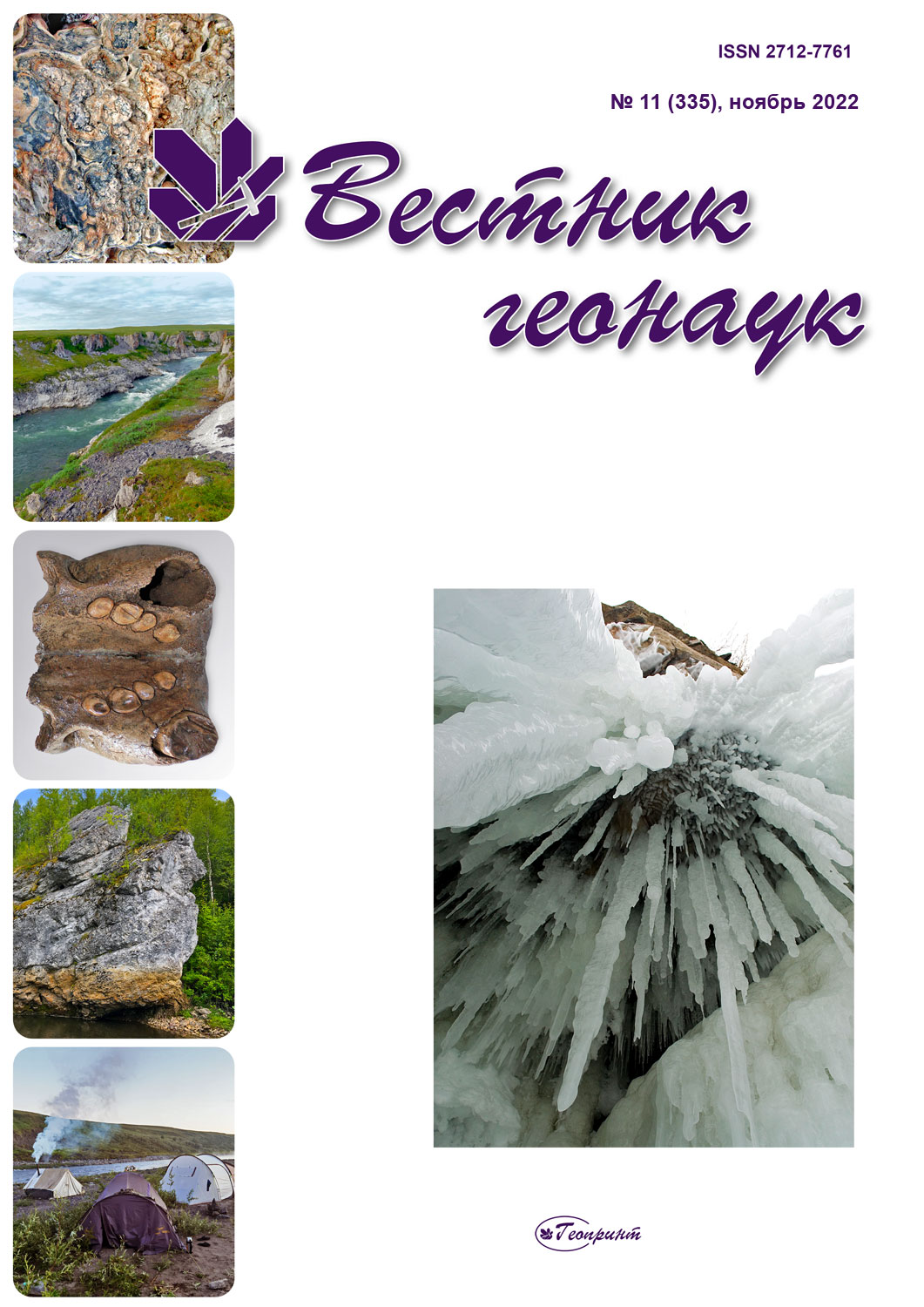pdf № 335, November
226 downloads

|
1 |
|
|
2 |
|
|
On the cover: ice stalactites in the grotto at Lake Baikal. Photo by A. Peretyagin. |
|
|
Научные статьи / Scientific articles |
|
A new ostracod species of the genus Leperditia from the Silurian deposits of the western slope
|
3—10 |
Geochemical zonality of ore lode of Novo-Uchaly VMS deposit
|
11—19 |
Problem of building units in crystal growth and genesis of non-classical concepts of crystal formation A. M. AskhabovDOI: 10.19110/geov.2022.11.3 On the basis of the analysis of dramatical history of development of the concepts of building units in crystal growth we discuss the genesis of non-classical concepts of crystal growth. We show that in the 21st century the competent advantage in the theory of crystal growth transits to notions about building units larger than individual atoms and molecules. New experimental data, testifying to a stable life of prenuclear clusters-quatarons or other organized groups of atoms in crystal-forming environments and their participation in crystal growth and also already formed crystalline particles, allow not only solving the old “Kossel vs. Balarev” problem, but also proving non-classical mechanisms of crystal growth. Keywords: non-classical mechanisms of crystal growth, nucleation and growth of crystals, growing units, prenuclear clusters, quatarons. |
20—24 |
Preparation of tetraethoxysilane to obtain spherical silica particles. Part 1. Ultrafiltration D. V. KamashevDOI: 10.19110/geov.2022.11.4 The paper considers the problem of instability of tetraethoxysilane hydrolysis in an ethanol medium in the presence of ammonia as a catalyst to obtain monodisperse spherical silica particles of a given size. This problem is associated with the presence of various impurities affecting rate of particle formation and, as a consequence, their size, monodispersity and shape. To solve this problem, we present novel studies of possible application of ultrafiltration for hydrolysis of initial tetraethoxysilane and ethanol through hydrophobic filters with a pore size of 50 nm. In both cases, we noted a decreasing intensity of light scattering after filtration. The elemental analysis of filtered impurities showed a significant content of SiO2 solid phases in tetraethoxysilane, and a number of impurities in ethanol. The experiments on the synthesis of silica particles from pre-filtered components showed that the resulting silica particles had a greater degree of monodispersity, and their sizes were much more reproducible, regardless of the used tetraethoxysilane. Thus, according to the obtained data, ultrafiltration is one of the effective ways to solve the problem of instability in the synthesis of monodisperse spherical silica particles. Keywords: monodisperse spherical silica particles, supramolecular structures, ultrafiltration. |
25—34 |
Comparison of 210Pb dating models as applied to peat deposits of the European Subarctic of Russia (evidence from the Arkhangelsk region) E. U. Yakovlev, A. A. Kudryavtseva, A. S. OrlovDOI: 10.19110/geov.2022.11.5 The dating of young peatlands with 210Pb method is a difficult task. Standard 210Pb dating models require an exponential decrease in activity down the peat profile. In Arctic peatlands, we note a significant migratory capacity of lead, therefore, for accurate dating of peat, it is necessary to improve the existing dating models to eliminate the effect of migration and their verification using independent isotope chronometers, for example, 137Cs. We applied several models CA, CFCS, PF, CF together with the Monte Carlo method for peat core samples taken within the European Subarctic of Russia (Arkhangelsk region). Comparison with the specific activities of 137Cs, determined at a depth of 19—21 cm, associated with the global fallout in 1963, showed that the closest age to the specified reference point is given by the CFCS and CF models (1965 and 1962, respectively). Among these two options, CF using the Monte Carlo method turned out to be preferable, since it provided, taking into account the error, a slightly better agreement with the specific activities of 137Cs in the reference horizon. Despite the difficulties associated with the complex distribution of 210Pb over the peat section due to migration, the dating methods used were successful and, in the future, can be applied to dating other peat deposits. Keywords: peat core, dating, 210Pb, 137Cs, Arkhangelsk region, Russia. |
35—42 |
Mathematical approach to the study of the mullite synthesis process
|
43—46 |
| Chronicle, events, facts. History of Science | |
|
Kuryador section — the lost geological heritage of the Komi Republic |
47—49 |
|
Russian-Chinese online workshop |
50 |
|
The 31st scientific conference of young researchers |
51—52 |
- 8(8212)24-53-53
- institute@geo.komisc.ru
- Mon.-Fri. 8.00-17.00












